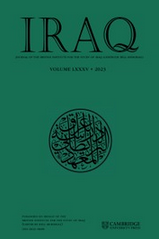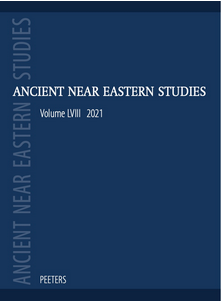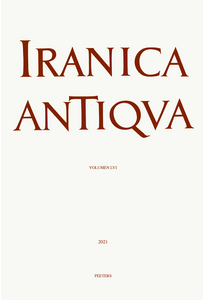Publications so far
0
| 1. |  | Amelirad, Sheler; Razmpoush, Abbas; Khanmohamadi, Behroz: Kani Charmou, an Iron Age II graveyard. In: Iraq, vol. 85, pp. 49-71, 2024. (Type: Journal Article | Abstract | Links | BibTeX)@article{nokey,Examining the archaeological findings within the Mannaean kingdom, a significant association with Assyria emerges, highlighting these regions’ interconnectedness. The influence of both Urartian and Assyrian cultures on the Mannaean people becomes evident, indicating a shared cultural heritage or intimate exchanges among these cultures. Notably, the Kani Charmou graveyard in Mannaea serves as a compelling example, revealing a rich assortment of artifacts that parallel those discovered in Ziwiye, a renowned archaeological site in the region. These diverse grave goods unequivocally demonstrate the existence of a robust trade and exchange network between Mannaea and its neighbouring western counterpart, Assyria, and the profound impact of Assyrian culture on Mannaean society. This connection is also evident in religious practices, which show similarities. Through stylistic analysis and the identification of parallels in metal vessels, glazed jars, and a cylinder seal, the proposed dating of the Kani Charmou graveyard aligns with the Iron Age II period. |
| 2. |  | Amelirad, Sheler; Mohajerynezhad, Abdolrezer; Javidkhah, Masoume: A Report on the Excavation at the Mala Mcha Graveyard, Kurdistan, Iran. In: Iran, vol. 55, iss. 2, pp. 171-207, 2017. (Type: Journal Article | Abstract | Links | BibTeX)@article{nokey,The Mala Mcha graveyard is located in Iranian Kurdistan, near the ancient Mannaean site of Ziwiya. Abdolreza Mohajerynezhad and Rasol Oshtodan conducted rescue excavations at Mala Mcha in 2012, and 16 graves were uncovered. Although most of the graves had been plundered by tomb robbers the tomb structures, and especially the grave-goods that remained, suggest an Iron Age III date and close relations with neighbouring sites such as Ziwiye, Qalaichi and Changbar. Most of the graves were covered with large flat slabs and contained one, two or three burials, the exception being tomb no. 7 with 14 burials. |
| 3. |  | Amelirad, Sheler; Razmpoush, Abbas: A Newly Discovered Iron Age Site at Sarrez, Iranian Kurdistan. In: Ancient Near Eastern Studies, vol. 52, pp. 207-216, 2015. (Type: Journal Article | Abstract | Links | BibTeX)@article{nokey,Sarrez is an ancient site in Kurdistan Province, Iran, near the present-day country town of Kamyaran. This site was discovered accidentally during dam construction activities. It has yielded some metal artefacts, potsherds and bones that are comparable to Iron Age III instances. The collection in its entirety is discussed in this article. One of the main objects from Sarrez is a decorated beaker with a scene on its wall that is comparable in many ways to examples of Neo-Assyrian art. The purpose of this paper is to publish and date the metal objects of the Sarrez collection based on this bronze beaker, which is one the few beakers from western Iran which has been found in a secure context. |
| 4. |  | Amelirad, Sheler; Overlaet, Bruno; Haerinck, Ernie: The Iron Age “Zagros Graveyard” Near Sanandaj (Iranian Kurdistan): Preliminary Report on the First Season. In: Iranica Antiqua, vol. 47, pp. 41-99, 2012. (Type: Journal Article | Abstract | Links | BibTeX)@article{nokey,An Iron Age graveyard, for the most part dating from the 8th - 7th century BC, was accidentally discovered in 2008 during road works near Sanandaj, Iranian Kurdistan. Rescue excavations were conducted by the Cultural Heritage Department in Sanandaj. The present contribution reports on these first excavations during which more than 20 graves were discovered in two squares and a trench. A selection of the graves and the burial goods are discussed. |
2024 |
|
 | Amelirad, Sheler; Razmpoush, Abbas; Khanmohamadi, Behroz: Kani Charmou, an Iron Age II graveyard. In: Iraq, vol. 85, pp. 49-71, 2024. (Type: Journal Article | Abstract | Links | BibTeX | Tags: Iron, Iron Age, Kurdistan, Zagros, Zagros Highlands)@article{nokey,Examining the archaeological findings within the Mannaean kingdom, a significant association with Assyria emerges, highlighting these regions’ interconnectedness. The influence of both Urartian and Assyrian cultures on the Mannaean people becomes evident, indicating a shared cultural heritage or intimate exchanges among these cultures. Notably, the Kani Charmou graveyard in Mannaea serves as a compelling example, revealing a rich assortment of artifacts that parallel those discovered in Ziwiye, a renowned archaeological site in the region. These diverse grave goods unequivocally demonstrate the existence of a robust trade and exchange network between Mannaea and its neighbouring western counterpart, Assyria, and the profound impact of Assyrian culture on Mannaean society. This connection is also evident in religious practices, which show similarities. Through stylistic analysis and the identification of parallels in metal vessels, glazed jars, and a cylinder seal, the proposed dating of the Kani Charmou graveyard aligns with the Iron Age II period. |
2017 |
|
 | Amelirad, Sheler; Mohajerynezhad, Abdolrezer; Javidkhah, Masoume: A Report on the Excavation at the Mala Mcha Graveyard, Kurdistan, Iran. In: Iran, vol. 55, iss. 2, pp. 171-207, 2017. (Type: Journal Article | Abstract | Links | BibTeX | Tags: Chronology, Excavation, Iron, Iron Age, Kurdistan, Zagros Highlands)@article{nokey,The Mala Mcha graveyard is located in Iranian Kurdistan, near the ancient Mannaean site of Ziwiya. Abdolreza Mohajerynezhad and Rasol Oshtodan conducted rescue excavations at Mala Mcha in 2012, and 16 graves were uncovered. Although most of the graves had been plundered by tomb robbers the tomb structures, and especially the grave-goods that remained, suggest an Iron Age III date and close relations with neighbouring sites such as Ziwiye, Qalaichi and Changbar. Most of the graves were covered with large flat slabs and contained one, two or three burials, the exception being tomb no. 7 with 14 burials. |
2015 |
|
 | Amelirad, Sheler; Razmpoush, Abbas: A Newly Discovered Iron Age Site at Sarrez, Iranian Kurdistan. In: Ancient Near Eastern Studies, vol. 52, pp. 207-216, 2015. (Type: Journal Article | Abstract | Links | BibTeX | Tags: Iron Age, Kurdistan, Material Analysis, Zagros, Zagros Highlands)@article{nokey,Sarrez is an ancient site in Kurdistan Province, Iran, near the present-day country town of Kamyaran. This site was discovered accidentally during dam construction activities. It has yielded some metal artefacts, potsherds and bones that are comparable to Iron Age III instances. The collection in its entirety is discussed in this article. One of the main objects from Sarrez is a decorated beaker with a scene on its wall that is comparable in many ways to examples of Neo-Assyrian art. The purpose of this paper is to publish and date the metal objects of the Sarrez collection based on this bronze beaker, which is one the few beakers from western Iran which has been found in a secure context. |
2012 |
|
 | Amelirad, Sheler; Overlaet, Bruno; Haerinck, Ernie: The Iron Age “Zagros Graveyard” Near Sanandaj (Iranian Kurdistan): Preliminary Report on the First Season. In: Iranica Antiqua, vol. 47, pp. 41-99, 2012. (Type: Journal Article | Abstract | Links | BibTeX | Tags: Ceramics, Chronology, Excavation, Iron, Iron Age, Kurdistan, Pottery, Zagros, Zagros Highlands)@article{nokey,An Iron Age graveyard, for the most part dating from the 8th - 7th century BC, was accidentally discovered in 2008 during road works near Sanandaj, Iranian Kurdistan. Rescue excavations were conducted by the Cultural Heritage Department in Sanandaj. The present contribution reports on these first excavations during which more than 20 graves were discovered in two squares and a trench. A selection of the graves and the burial goods are discussed. |
